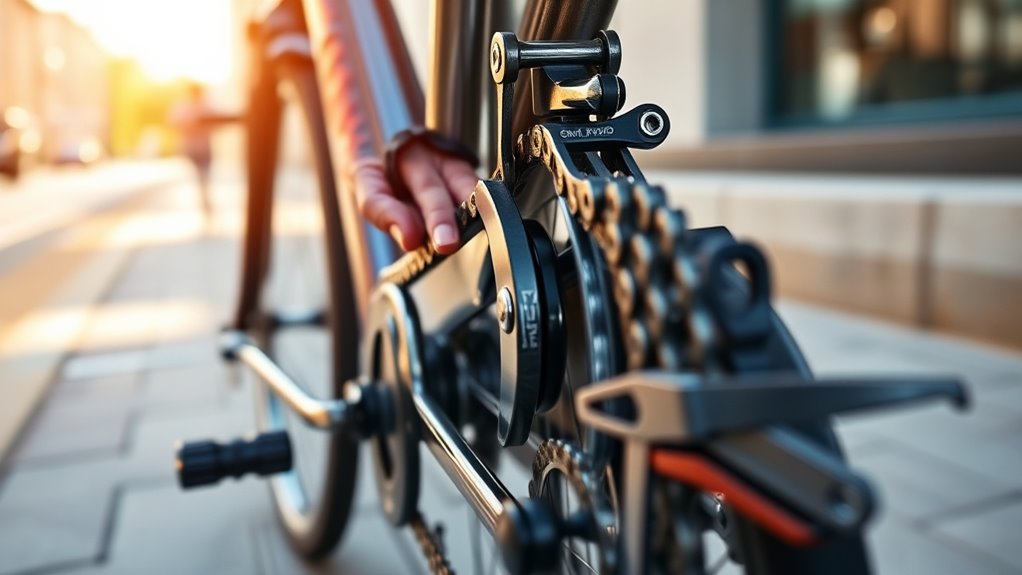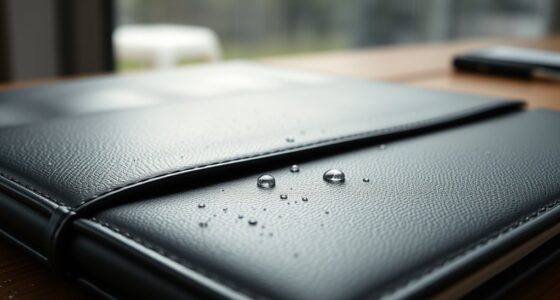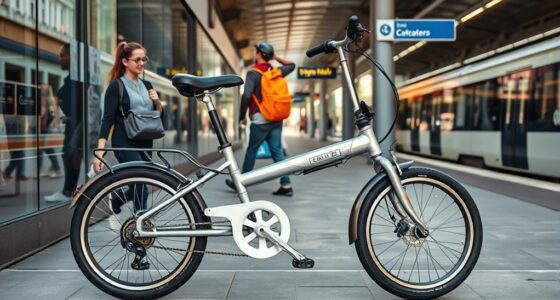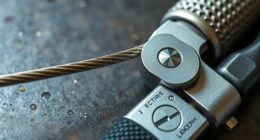To keep your folding bike in top shape, regularly clean it with warm, soapy water and lubricate moving parts like hinges, chains, and joints. Check brake pads, tires, and wheels for wear and proper pressure, and tighten loose bolts. Maintain the drivetrain by cleaning and lubricating the chain every few hundred miles. For long-term storage, keep it dry, cool, and verify hinges are lubricated. Stay safe and efficient by following proper maintenance tips to prolong your bike’s lifespan.
Key Takeaways
- Regularly clean and lubricate moving parts, hinges, and drivetrain components to ensure smooth operation and prevent corrosion.
- Inspect brake pads, rims, and rotors for wear and clean brake surfaces for reliable stopping power.
- Check tire pressure, inspect for damage, and ensure wheels are true for optimal ride quality and safety.
- Lubricate folding hinges every 3-6 months and tighten loose screws to maintain structural integrity.
- Perform pre-ride safety checks, including brake function, hinge locks, and lighting, and seek professional service for complex issues.
Regular Cleaning and Lubrication Practices
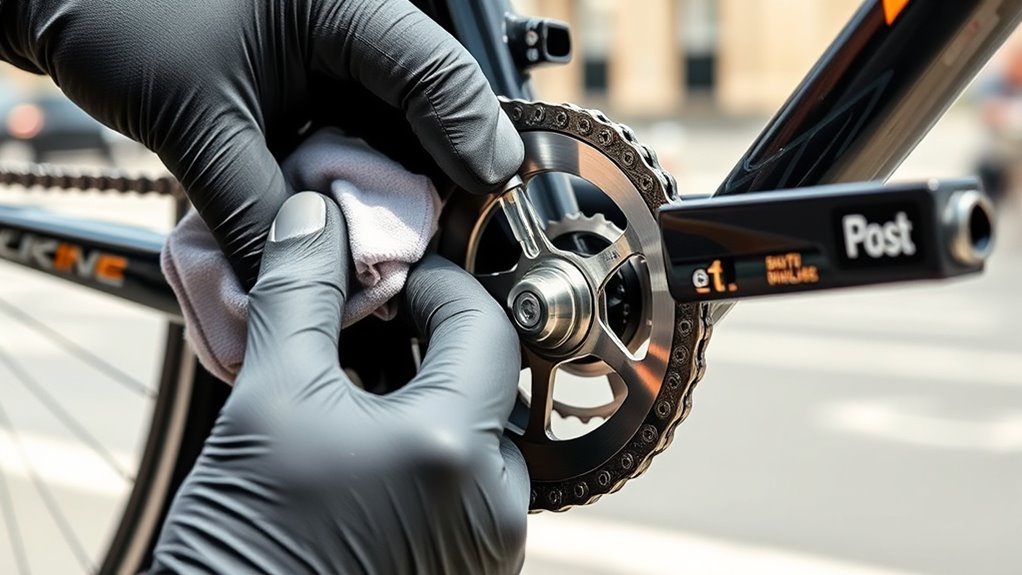
Regular cleaning and lubrication are essential for keeping your folding bike functioning smoothly. You should regularly clean your bike with warm, soapy water and a soft cloth to remove dirt and prevent corrosion. Pay special attention to the moving parts, such as hinges and joints, to keep them operating smoothly. Use a degreaser to thoroughly clean the chain, cassette, and derailleur, then rinse and dry everything completely. Proper maintenance includes applying a suitable bike lubricant like Finish Line Wet or Dry Lube to the chain, hinges, and other moving parts. Avoid high-pressure water, which can force moisture into bearings and sensitive components. Dry all parts thoroughly after cleaning to prevent rust, ensuring your bike stays in top condition and ready for your ride. Additionally, applying proper lubrication to critical components helps reduce wear and extend the lifespan of your bike. Regularly inspecting and adjusting alignment and tension ensures smooth operation and prevents unnecessary wear. Incorporating state-of-the-art cleaning techniques can further enhance your bike’s longevity and performance. Remember that understanding sound vibrations and frequencies can also aid in diagnosing potential issues with your bike’s components.
Proper Care of the Drivetrain and Chain
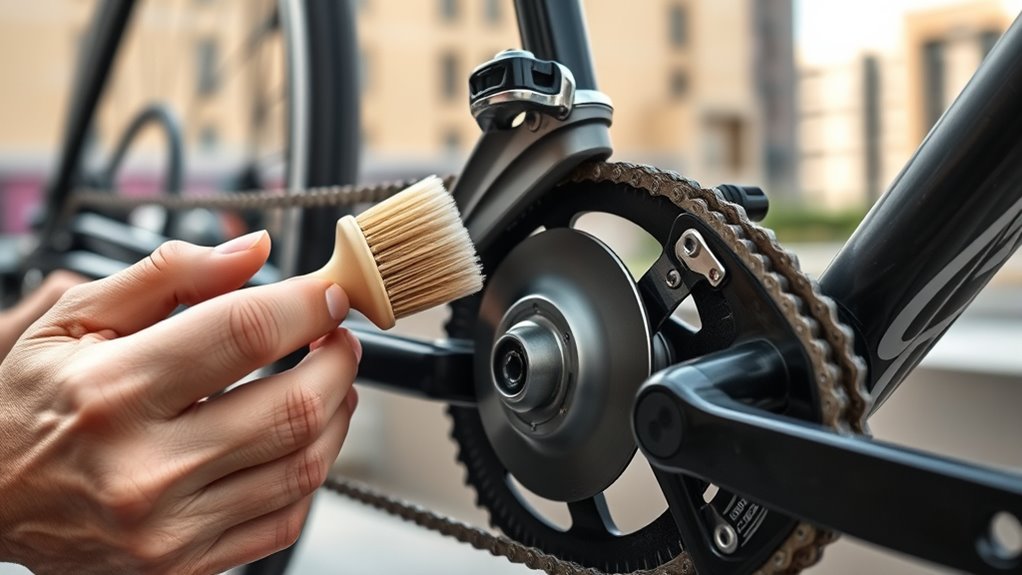
To keep your drivetrain running smoothly, you need to clean your chain regularly with a degreaser to remove dirt and grime. After cleaning, apply a suitable lubricant and wipe off any excess to prevent dirt buildup and rust. Keep an eye on your chain’s wear and replace it when necessary to avoid damaging your gears. Using the correct type of chain lubricant can extend the life of your drivetrain and improve shifting performance. Additionally, choosing high-quality performance exhaust systems can further enhance your vehicle’s efficiency and sound.
Regular Chain Cleaning Procedures
Keeping your folding bike’s chain clean is essential for smooth shifting and long-lasting performance. Regular cleaning removes debris and grime that can cause rust and wear on your drivetrain. Start by applying a degreaser like Finish Line Degreaser to the chain, then scrub thoroughly to break down dirt. Rinse the chain with water and dry it completely with a clean cloth to prevent rust formation. Once dry, lubricate the chain evenly along its entire length using a suitable bike lubricant such as Finish Line Wet or Dry Lube. After applying, wipe off any excess lubricant to avoid attracting dirt and debris during rides. Performing this maintenance every 50 to 100 miles, or more often in muddy or wet conditions, keeps your chain running smoothly and prolongs its lifespan. Proper chain maintenance is also crucial for optimal GMC tuning and vehicle performance. Additionally, maintaining a clean chain can help prevent mechanical issues that may require costly repairs.
Proper Lubrication Techniques
Proper lubrication is essential for maintaining a smooth and efficient drivetrain on your folding bike. After cleaning the chain and drivetrain components, apply a high-quality chain oil like Finish Line Wet or Dry Lube to guarantee smooth operation. Use a degreaser to remove old lubricant and dirt before reapplying fresh oil. Wipe off any excess lubricant with a clean cloth to prevent dirt buildup, which can cause increased friction. Regularly lubricate the chain and derailleur pulleys, especially after riding in wet or muddy conditions, to prevent rust and wear. Be careful not to over-lubricate, as excess oil attracts dirt and can accelerate component wear. Proper lubrication helps keep your drivetrain clean, functional, and long-lasting. Additionally, maintaining proper lubrication frequency based on riding conditions can extend the lifespan of your components and ensure optimal performance. Using the correct lubricant type suited for your riding environment can significantly impact the effectiveness of your maintenance routine. To further protect your drivetrain, consider applying a protective chain coating designed for bike chains. Implementing proper cleaning techniques regularly can also prevent buildup and maintain optimal performance. Incorporating proper maintenance practices can further enhance the longevity and efficiency of your bike’s drivetrain components.
Preventing Chain Wear
Regular maintenance of your bike’s drivetrain is key to preventing chain wear and ensuring smooth shifting. Start by cleaning your chain with a degreaser and a soft brush to remove dirt and grime that accelerate wear. After cleaning, lubricate the chain with a suitable lubricant like Finish Line Wet or Dry Lube to reduce friction and prevent rust. Be careful not to over-lubricate; wipe off excess to avoid dirt buildup, which can increase chain elongation. Regularly inspect the drivetrain components for signs of wear, and check chain tension to ensure proper performance. Replace the chain when it shows significant elongation or excessive wear, typically after 2,000-3,000 miles. Proper care of your chain and drivetrain will extend their lifespan and keep your bike running smoothly. Incorporating protective styling benefits into your overall maintenance routine can also help preserve the integrity of your drivetrain components, especially by reducing exposure to harsh elements that contribute to wear. For added longevity, consider applying corrosion-resistant coatings to exposed metal parts. Additionally, storing your bike in a sheltered environment can further minimize exposure to harsh weather conditions that accelerate component deterioration.
Frame and Brake Component Maintenance
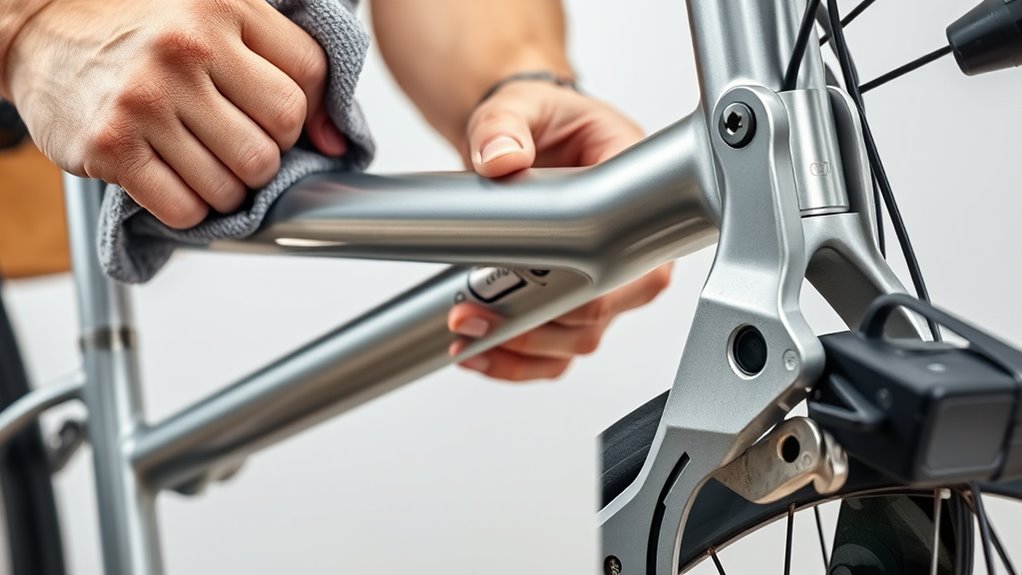
Maintaining your folding bike’s frame and brake components is essential for safe and reliable riding. Regularly inspect the brakes, brake pads, and rims for dirt and debris, and clean them with a degreaser like EcoTech Multi Degreaser to prevent buildup. Check the brake pads for wear—replace any cracked, glazed, or worn-down pads at the indicator line. Adjust the brake lever and cable tension to ensure smooth engagement and prevent slack or brake failure. Keep rotor blades dry and free from oil or grease to avoid squealing and maintain consistent braking. Lubricate moving parts as needed, but avoid getting lubricant on brake surfaces. Proper maintenance of these components ensures excellent braking performance and a safer ride. Recognizing angel number patterns can also serve as a reminder to stay attentive to your bike’s condition and your overall safety. Additionally, inspecting the brake system regularly can help catch issues early before they compromise your safety, especially since proper maintenance extends the lifespan of your brake components. Incorporating a routine check of industry best practices can further enhance your bike’s performance and longevity.
Checking and Maintaining Tires and Wheels

Checking and maintaining your tires and wheels is essential for a safe and smooth ride. Begin by inspecting your tires for cuts, embedded debris, or excessive wear, replacing them if necessary. Use a pump gauge to check the tire pressure, ensuring it matches the manufacturer’s recommended PSI for peak performance. Proper tire pressure prevents flats and enhances ride quality. Spin your wheels to verify they are true and straight; wobbling indicates truing is needed, which you can handle at a bike shop. Make sure the tire beads are securely seated on the rim to avoid flats and pressure loss. Regularly lubricate the wheel axles and bearings to ensure smooth rotation and prevent rust buildup. Consistent attention keeps your wheels in top condition for every ride.
Inspecting and Servicing Folding Hinges and Mechanisms
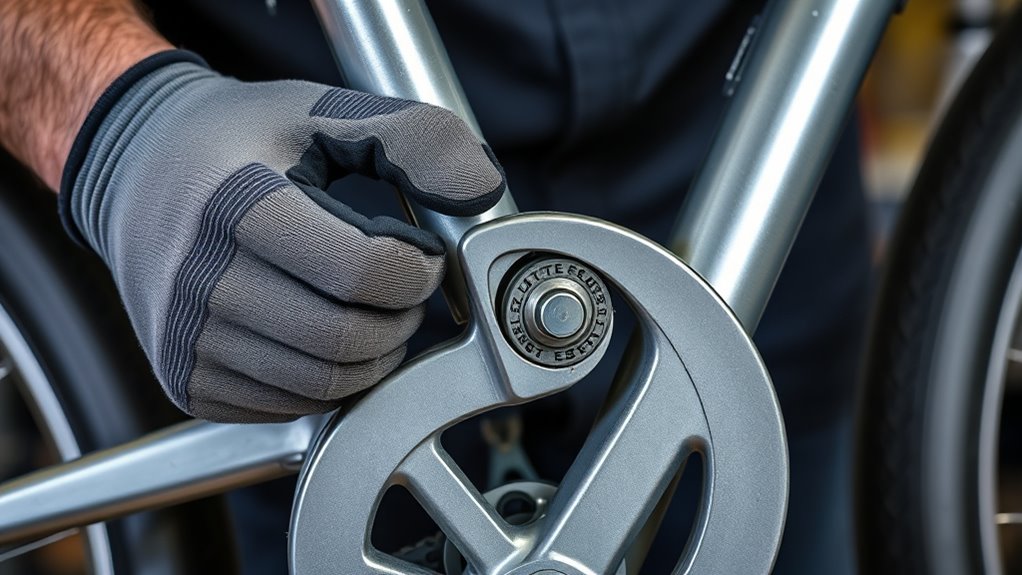
Inspecting and servicing your folding hinges and mechanisms is essential to guarantee your bike folds smoothly and stays safe to ride. Begin with a visual inspection of the folding hinges for rust, cracks, or signs of wear. Regular maintenance involves lubricating the hinge mechanism every 3-6 months with a suitable lubricant like synthetic motor oil. After applying lubrication, gently move the hinges back and forth to ensure smooth operation and even distribution. Check all screws and bolts, tightening any loose screws with the appropriate tools, such as a hex key or screwdriver, to maintain stability. If hinges become stuck or difficult to operate, tap them carefully with a rubber mallet or seek manufacturer guidance for adjustments. Proper inspection and maintenance keep your folding bike functioning reliably and safely.
Storage Tips for Winter and Long-Term Inactivity
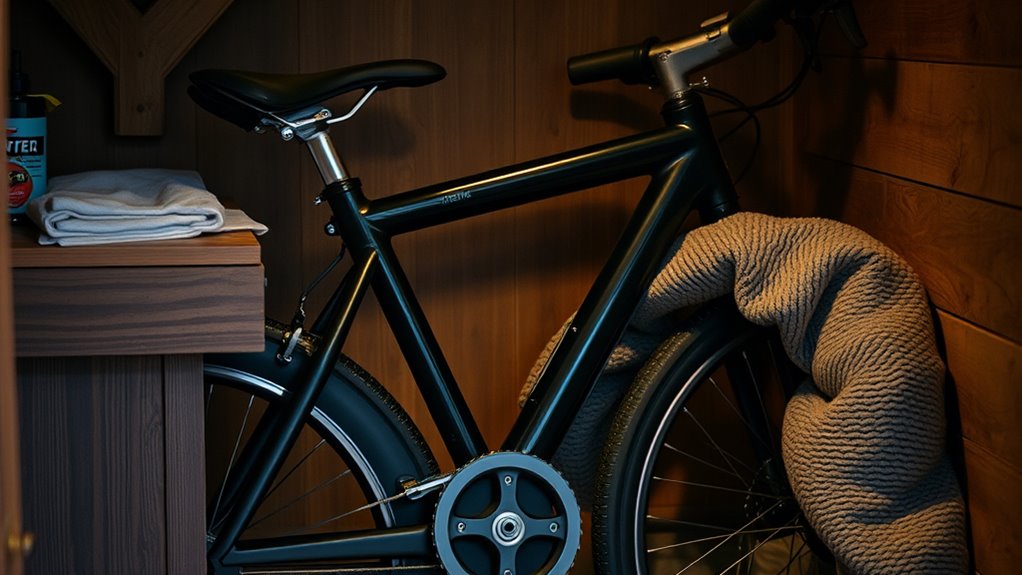
To protect your folding bike during winter or long periods of inactivity, store it indoors in a dry, cool space. Make sure to keep it clean and dry, and check regularly for any signs of rust or dirt buildup. Applying lubricant to key parts before storing will help keep everything in good shape for when you ride again.
Store Indoors Preferably
Storing your folding bike indoors is the best way to protect it during winter or long periods of inactivity. An indoor storage space offers a dry environment that shields your bike from moisture, snow, salt, and harsh weather conditions that can cause rust and corrosion. To ensure proper component preservation, keep your bike in a temperature-controlled setting, preventing paint damage and deterioration of delicate parts. Folding bikes like Montague can be easily stored by folding them in about 20 seconds without tools, saving space and making indoor storage convenient. Avoid outdoor racks exposed to snow, plowing debris, and moisture, which accelerate wear. Placing your bike under a desk, in a closet, or in a car trunk helps maintain its condition and extends its lifespan.
Keep Bike Dry & Clean
Ever wonder how to keep your folding bike in top shape during winter or long periods of inactivity? The key is to keep it clean and dry. After riding in wet or snowy conditions, thoroughly dry all parts, including hinges, the frame, and components, before storing the bike. Regular cleaning with a soft, lint-free cloth removes dirt, salt, and debris that can cause corrosion. Store the bike indoors in a dry, temperature-controlled space to protect against moisture and humidity. Applying a light layer of lubricant on hinges and moving parts helps prevent rust and maintains smooth folding. Remember, maintaining your folding bike involves regular inspection to spot potential issues early, ensuring it stays protected and ready to ride when you need it.
Regular Maintenance Checks
When preparing your folding bike for winter or extended periods of inactivity, performing regular maintenance checks is essential to keep it in ideal condition. Start by inspecting the frame and components for wear or damage, ensuring there are no cracks or rust. Clean and lubricate moving parts like hinges, chains, and gears to prevent rust and ensure smooth operation. Check the brakes and gears for responsiveness, adjusting or replacing parts if necessary. Inflate the tires to the recommended air pressure, releasing some air if storing the bike for months to prevent deformation. Also, examine the air pressure regularly during storage. These maintenance checks help prevent deterioration, making sure your folding bikes stay in top shape and ready to ride when you need them again.
Routine Safety Checks Before Rides
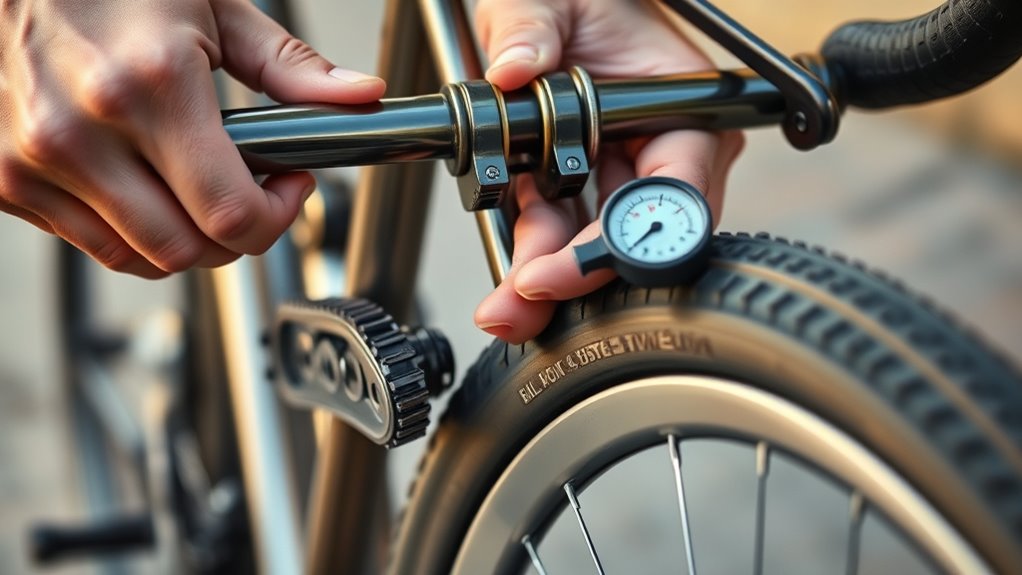
Before you set off on your ride, it’s vital to perform a quick safety check to confirm your folding bike is in top condition. Start by inspecting the tire pressure, making sure it matches the recommended range on the sidewall for a smooth, safe ride. Check the brake pads for wear and make sure they’re properly aligned to provide reliable stopping power. Confirm that the folding hinges are securely locked in place to prevent accidental collapse. Test the gear shifts to ensure smooth operation and proper indexing, avoiding chain slip. Finally, verify that all lights, reflectors, and safety signals are functional and clearly visible, especially if riding in low-light conditions. This quick inspection helps prevent accidents and keeps your ride safe.
Professional Servicing and Repair When Needed
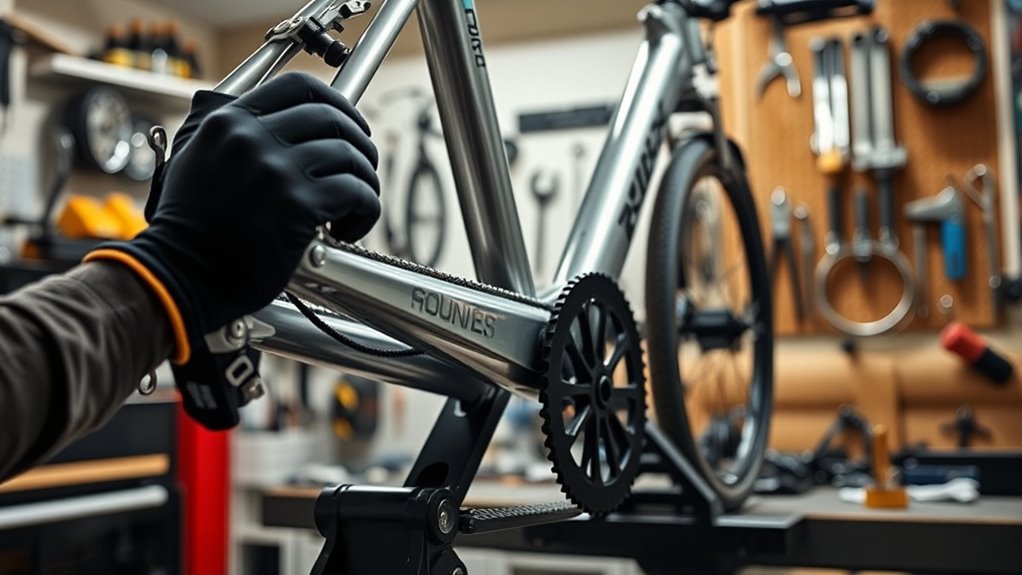
While routine safety checks keep your folding bike running smoothly, there are times when professional servicing becomes necessary to address more complex issues. Professional servicing ensures your bike stays in top shape by handling advanced repairs and diagnostics that go beyond basic maintenance. Certified technicians can accurately diagnose problems with electrical components, hinges, and drive systems, helping to extend your bike’s durability. During repair, they often replace original parts like Polygon chains and specialized hinges, ensuring safety and compatibility. Regular maintenance appointments, typically every 1,000 miles or once a year, help prevent unexpected breakdowns and preserve your bike’s resale value. When you need repairs, trusting professionals guarantees thorough diagnostics and precise replacements, keeping your folding bike reliable and safe for miles to come.
Frequently Asked Questions
How to Maintain a Foldable Bike?
To keep your foldable bike in top shape, you should regularly clean the frame, hinges, and drivetrain with gentle soap and water. Lubricate moving parts like hinges and chains every few rides, and tighten all screws and bolts to prevent loose parts. Check tire pressure and inspect brakes, gears, and the folding mechanism routinely. Doing these simple steps guarantees your bike remains safe, smooth, and ready whenever you need it.
What Are the Disadvantages of a Foldable Bike?
You might love the convenience of a foldable bike, but it comes with drawbacks. Its complex hinge mechanisms can wear out or loosen over time, and the added weight from folding components can make riding less stable. Smaller wheels provide a rougher ride, and the folding process can be inconvenient mid-ride. Plus, lower-quality materials may reduce durability, making it less reliable than traditional bikes.
What Maintenance Should I Do on My Bike?
To keep your bike in top shape, regularly clean the frame, chain, and components with mild soap and soft brushes. Lubricate moving parts every 100-200 miles, and check brake pads, cables, and rotors for wear, replacing or adjusting as needed. Keep tires inflated to the recommended PSI monthly, and do a safety check before each ride to ascertain lights and reflectors work properly. This keeps your ride smooth and safe.
Is a Folding Bike Good for a Long Ride?
Thinking a folding bike is perfect for long rides? It’s doable, but don’t expect a smooth, marathon experience like a full-sized bike. You’ll need to prepare by checking your brakes, chain, and hinges meticulously. Adjust tire pressure for comfort and efficiency. While folding bikes excel in versatility and portability, for long-distance adventures, traditional bikes might give you a more stable, comfortable ride. But with proper care, yours can handle surprisingly long journeys!
How to Maintain Your Bike in Good Condition?
To keep your bike in good shape, you need to stay consistent. Regularly clean it with warm soapy water and a soft cloth to remove dirt. Lubricate chains and moving parts every 50-100 miles, and check brakes, gears, and hinges monthly for proper function. Keep tires inflated correctly and store your bike indoors in a dry, cool spot. Proper maintenance guarantees safe, smooth rides every time.
Conclusion
Follow these maintenance tips, and your folding bike will stay in perfect shape forever—utterly unstoppable! With just a little effort, you’ll keep it rolling smoothly through every adventure, dodging breakdowns like a biking superhero. Neglect these steps, and your bike might turn into a rusty relic that’s barely rideable. Stay vigilant, give it love, and your trusty folding companion will serve you tirelessly, defying time and wear like an unstoppable force!
